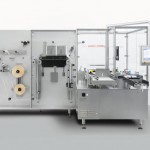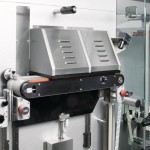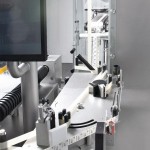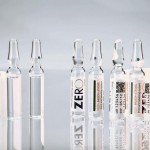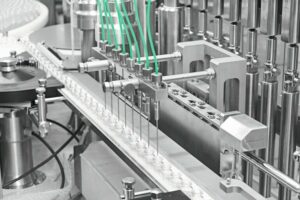The label on a bottle of medicine is taken for granted by every patient and usually given no further thought. Everyone expects to see the correct product name, manufacturer, expiry date and further information in their own language. The logistics necessary to apply the right label to the right vial or ampoule only become evident on closer examination. A labelling centre which prints blank labels, checks them and then applies them immediately to the appropriate container now simplifies this process enormously for pharmaceutical manufacturers.
The author: Tanja Bullinger Head of Public Relations, Bausch+Ströbel
Up to now, labels have had to be produced in advance in different versions – above all in several different languages – and kept in stock. If the labels were not delivered in time, the production process was interrupted. On the other hand, if they were stocked up too early, a change in the print content or design, however small, could mean that these labels were no longer any use. A daunting logistical challenge.
Stock-keeping is not the only issue – the label change procedure also slows down the production process. The labelling machines used in the pharmaceutical industry are usually high-capacity lines with a throughput of up to 48,000 containers per hour. However, there is a discernible trend towards small batches, partly due to worldwide marketing. The language of the label often has to be changed after only a few thousand vials or cartridges and this label change reduces the high output of the labelling machine unnecessarily.
Nowadays, many labelling machines are equipped with label printers. Unfortunately, these are only suitable for adding a code or other simple information such as an expiry date and they usually only print one colour. Hapa, the Swiss printing specialist, wondered if it would be possible to print the whole label at this station – what’s more, in a four-colour process. To achieve this goal, it is not enough merely to develop a suitable printer. On the contrary, the unit must also be integrated into a labelling machine. A solution was found in cooperation with the German machine manufacturer Bausch+Ströbel, a business partner in previous joint ventures.
High-quality printing
The versatile labelling centre consists of a label web splicer that allows the label supply roll to be exchanged without interrupting production (with a take-up reel for the empty web), a four-colour inkjet printer based on the Hapa 800 LabelJet for printing complete labels and a high-capacity Bausch+Ströbel ESA 1025 labelling machine. The splicer feeds the blank labels to the labelling machine and later winds up the empty web. The label is then printed – both with the standard text and with individual information such as codes, a batch number or an expiry date. The print quality is important: everything must be clearly legible and not distorted and the print must of course be long-lasting. The printer uses state-of-the-art UV “Drop On Demand (DOD)” InkJet technology with drop placement at up to 720 dpi. Product information and variable data can be printed in a single pass, thereby easily meeting requirements for unit dose coding as well as sequential and randomised numbering. Text, bar and matrix codes, graphics and images are applied to the label in one to four spot colours or CMYK process printing. Production data can be loaded from various sources via a safe, digital interface. Line stoppages have no impact on print quality or efficiency thanks to an intelligent control that ensures the interrupted print cycle is completed and prepares the system for a fast restart. When the batch changes, the print system selects a new data record. All records are stored in the system as recipes. Pre-printed labels can of course also be used.
100 % checked
Particularly in the pharmaceutical industry, it is eminently important that every single container is labelled correctly and completely. A mistake here could have dire health implications. The information printed on each and every label is therefore checked 100 % by a camera – at print speeds of up to 30 m/min. Variable data such as codes or expiry dates are checked with a second camera on the label dispenser (OCR scan). The printed label is transported immediately to the labelling machine, which can handle up to 48,000 containers per hour. Ampoules, cartridges, bottles, vials and other – even unstable – containers can be labelled in this way.
The labels produced by the printer are supplied to the labelling position by a servo-controlled label dispenser in an intermittent motion that is synchronised with the machine. The labels are peeled off the web and transferred to the respective containers during the container transport. The label web advance is controlled by an electronic label dispenser controller according to the label length. The patented, so-called “reference run” also saves this advance distance as a reference value and makes sure each label is dispensed precisely even if labels are missing on the web. Double labelling is thereby prevented and every single label is processed at each individual station. Not only the printer is versatile but also the labelling machine. Size changes can be carried out quickly and easily by replacing complete sets of size parts. The labelling height can be adjusted to any level and reproduced due to the digital position display.
Advantages for users
The labelling centre is not just a juxtaposition of a label printer and labelling machine but an integrated concept with a single machine guard, PLC, etc. It meets all the requirements of the pharmaceutical industry (GMP and FDA). Yet what advantages does the centre offer for users compared to conventional solutions? Firstly, it increases the labelling speed. Every minute, 800 complete labels are printed, checked and applied to containers – equivalent to 13.3 per second. The system also provides greater flexibility as only blank labels are kept in supply instead of a range of different pre-printed labels. For drugs that are marketed worldwide, labels in up to 80 different languages or designs are not uncommon. The benefits of this system are immediately obvious. Changes to the basic label can be made in next to no time and pre-printed labels are also supported.
The trend towards small batches will become more pronounced in the future. Biotechnological developments even envisage the production of medicines for treating one specific patient. The costs per unit are considerably higher for small quantities than for large ones. Thanks to the new labelling process, at least the packaging can be automated, making it faster and more affordable. The demand observed so far is a clear indicator that such a need exists. Several orders were placed shortly after the labelling centre made its debut.
cpp-net.com/0312456
Share:



